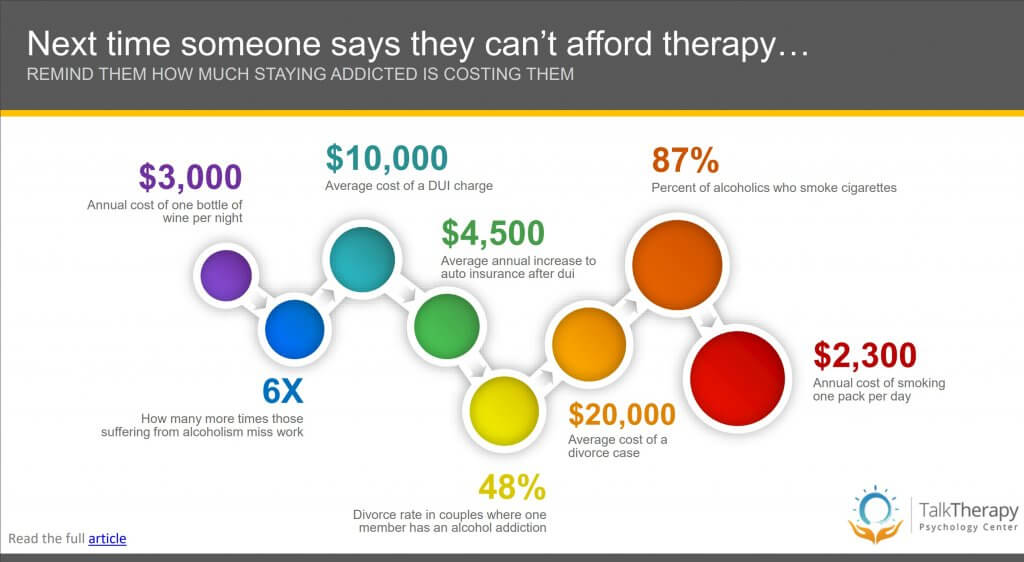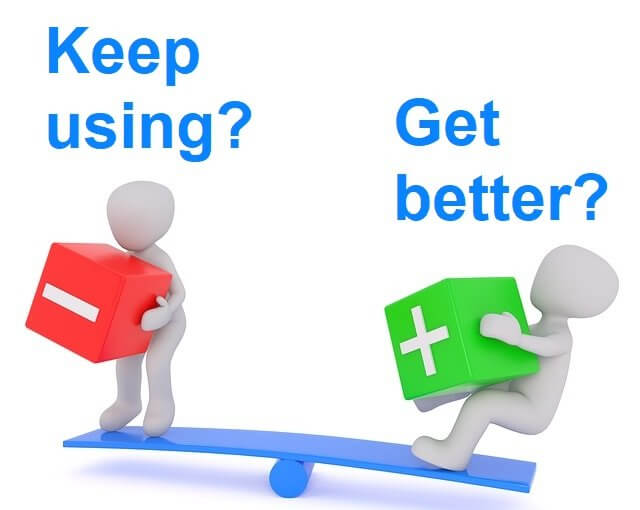We encourage our clients to shop around for not only the best therapist but also the best prices. This is especially true when your insurance does not cover an adequate portion of outpatient rehab costs. However, we are often surprised by people who do not pursue treatment altogether because they believe it is “too expensive”. Similarly, we are surprised when patients cut their treatment short because of financial considerations. Don’t get us wrong, we understand that getting treatment for substance abuse, whether it is through individual sessions or through intensive outpatient programs (IOP), can be expensive. But money should not be the sole consideration when foregoing treatment altogether or when stopping the therapy before enough positive changes have been made. The reason we say this is because we believe that returning to the addiction can be even more expensive, not only in intangible ways, but also in very real tangible costs.
Here are some tangible and intangible costs of continuing to use:
1. Risk of dying
First there is the possibility of dying. We are not sure this should be categorized as a tangible or an intangible cost but we certain believe it is an important one. It has been reported that excessive alcohol use kills about 88,000 people in the United States.
2. Cost to society
Substance abuse results in behaviors that cost the whole society quite a bit. Research indicates that the primary costs come from losses of productivity in the workplace, healthcare expenses from treating the substance abuse symptoms and outcomes, law enforcement and criminal justice costs, and motor vehicle related costs. In fact, it is estimated that alcohol use costs the US a staggering $200 Billion per year.
3. Cost of missing work
The most significant problems that companies experienced due to addiction are absences from the workplace, reduced productivity, missed deadlines, and increases healthcare costs.
4. Direct cost of spending on purchasing alcohol
We use alcohol as an example because it is easily researched, though you can substitute illegal substances in here as well. For instance, the costs of drinking a bottle of wine, or a case of beer, per night, comes out to approximately $3,00 per year.
5. Cost of car accidents and DUIs
Almost one third (29%) of all traffic-related deaths in the US are due to alcohol-impairment. In 2015, 10,265 people died in alcohol-impaired driving crashes.
There are obviously many more incidents that did not result in deaths. Every year, 708,000 persons are injured in alcohol related crashes; 74, 000 of those people suffer serious injuries.
One study suggests that there were as many as 111 million self-reported episodes of alcohol-impaired driving in the US in 2015. That year, nearly 1.1 million drivers were arrested for driving under the influence of alcohol or narcotics. This number has gone up to as much as 1.5 million arrests, per another study.
In the case where the driver is stopped for a DUI charge, the fines are significant. It is estimated that the total cost of a DUI that goes to trail is between $8k and $10k. That’s once you add legal fees, rehabilitation fees, increases to your car insurance, and other associated costs from the whole ordeal.
Keep in mind that the increase to your car insurance is not a one-time fee. It takes years of good behavior to get your premium back down again. On average, your car insurance will increase by $3,000 to $6,000 per year.
6. Cost of divorce
While divorce is common in the us, with a first-time divorce rate hovering around 40%, it is interesting to note that the rate is 50% when one spouse drinks heavily. That’s a 25% higher rate than the national average. With the average cost of a contested divorce ranging from $15K to $35K, this is a very real and substantial cost. Obviously, drinking is not the only reason people in this one study got a divorce, the increase in the statistic was significant.
7. Associated smoking expense
According to the NIH, between 80% and 95% of alcoholics smoke cigarettes. Based on CDC estimates, someone who smokes a pack a day spends roughly $2,300 per year.
8. Work absence
Absenteeism is estimated to be on average 6 times greater among alcoholics and alcohol abusers, than the general public. This not only impacts the employer, it also impacts the individual who is potentially hurting chances at a raise, or a promotion. Obviously, absenteeism can also get someone fired.
Additionally, in one study, workers with alcohol problems were nearly 3 times more likely to have injury-related absences, than the general public.
9. Other costs
There are obviously many other general costs that could be considered. For incidents that result in some injury, there are hospital and medical bills to cover. There are also unintentional injuries that may result from being under the influence.
Apart from medical bills, there are other unpaid bills that can add up, as people forego tending to their responsibilities as a result of their addiction.
The list goes on and on. So, now, with those costs in mind, let’s look at what treatment may cost you.
In general, there are a few paths that one can take when seeking treatment for substance abuse. There are inpatient programs, outpatient rehab programs, such as Intensive Outpatient Programs (IOP), partial hospitalization, and outpatient individual sessions.
Cost of Inpatient Care
Inpatient rehab will cost you anywhere between a few thousand dollars to upwards of $60,000 for a month of treatment. There is such wide range largely due to location, the amount of services provided, and the center’s reputation. A basic, low-cost 30-day residential rehab will be in the range of $2 to $7k. your standard residential inpatient treatment will go up from there all the way to $20,000 per month. Above that amount, you enter into the world of premium, luxury, and so-called executive residential inpatient rehab centers. Such options will offer a fast range of amenities on premises, several therapy alternatives, and the highest quality of accommodations.
Costs of Outpatient Care
Intensive outpatient program (IOP) participation will range between a few thousand and $10,000. Such programs can be very effective while also allowing you to continuing carrying on with your life’s responsibilities, including work, and family care.
It should be noted that both inpatient and outpatient rehab centers can take insurance. You should consult your insurance or talk to the treatment center you are considering to understand what your insurance covers.
Cost of Detox Centers
Sometimes, detox is first required before therapists can start working with you. Often, this is in response to a significantly compromised individual who requires some return to normalcy before pursuing treatment or returning to their daily lives. Detox treatment centers will typically charge by the day and the range can be anywhere between a few hundred dollars to $1,500 per day. Again, the location, reputation, and amenities of the facility play a big role in the big range in costs.
As always, we encourage people to consider their options. Sometimes, a few individual sessions is all you need to get back to balance. Other times, a more intensive treatment option may be warranty. However, we would like to encourage all those who are dealing with substance use issues to seek help. Even if you pursue a free, community-based solution, it is better than doing nothing. It will also get you moving into the right direction.
If you have any questions about the above, or would like to understand your options for treatment, please don’t hesitate to reach out to us.
All the best.
Dr. Seda Gragossian
858 205-2490
www.TalkTherapyCenter.com
Download our free eBook to learn everything there is to know about Intensive Outpatient Programs!
Resources
https://www.cdc.gov/features/costsofdrinking/index.html
https://www.cdc.gov/motorvehiclesafety/impaired_driving/impaired-drv_factsheet.html
http://www.faddintl.org/pr/p5.html
http://onedui.com/dui-costs/
http://www.medicaldaily.com/heavy-drinking-will-lead-divorce-unless-both-partners-are-equally-alcoholic-263648
https://www.addiction.com/3003/will-alcohol-abuse-lead-divorce/
http://info.legalzoom.com/average-cost-divorce-20103.html
https://www.ncadd.org/about-addiction/addiction-update/drugs-and-alcohol-in-the-workplace
https://www.opm.gov/policy-data-oversight/worklife/reference-materials/alcoholism-in-the-workplace-a-handbook-for-supervisors/
https://pubs.niaaa.nih.gov/publications/aa39.htm
https://www.cdc.gov/tobacco/data_statistics/fact_sheets/economics/econ_facts/index.htm





